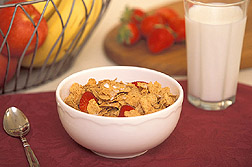Testing the Fortitude of Iron in Cereals |
|
 Many breakfast cereals are fortified with iron. Researchers at the Grand Forks Human Nutrition Research Center are evaluating various elemental iron powders to see which ones are most bioavailable. (K10137-2) |
Iron deficiency is the most common nutrient deficiency in the world. Yet as a dietary mineral, iron is essential for growth, development, and performance of daily tasks. Data from the National Health and Nutrition Examination Surveys, 1988-1994 and 1999-2000, shows that in the United States 11 to 12 percent of women aged 20 to 49 years were deficient in iron, and 4 to 5 percent had anemia, which can impair cognitive and immune functions. To address the deficiency problem, food manufacturers enrich flour, maize, and rice and fortify breakfast cereals with iron. Yet there is little research on the nutritional bioavailability of the various iron sources used to fortify foods today. Researchers at the ARS Grand Forks Human Nutrition Research Center, in Grand Forks, North Dakota, are seeking new information on the bioavailability of commonly used iron powders. They are collaborating with SUSTAIN (Sharing U.S. Technology to Aid in the Improvement of Nutrition) and its partners as part of an overall review of the bioavailability of elemental iron powders. For several decades, elemental iron powders have been the resource of choice for boosting iron content in breakfast cereals. These powders are produced through several different methods—each yielding a product with distinct physical properties, which in turn may affect bioavailability. Derived from iron ore, elemental iron powders are economical for producers, and they generally do not disturb the flavor or storage properties of the products to which they're added. But the traits that make them less reactive with foods may also decrease their nutritional bioavailability. A soluble form of iron known to be highly bioavailable, yet not itself an elemental iron powder, is ferrous sulfate. Although relatively inexpensive, it is not commonly used in staple foods because of its tendency to oxidize, which in turn discolors and degrades foods. Still, ferrous sulfate's high level of bioavailability serves as a gauge with which to compare the relative level of absorption of various iron powders. "The nutritional bioavailability of these powders is probably influenced by particle size, density, surface area, chemistry, and shape," says Janet R. Hunt, with the Grand Forks center. Hunt and research associate James H. Swain recently studied the bioavailability to rats of six commonly used elemental iron powders. They found that the ability of these powders to treat iron deficiency anemia in rats ranged from only 21 to 64 percent of that of ferrous sulfate. Moreover, bioavailability among the six powders differed significantly. That preliminary animal study helped the scientists select which powders to pursue for further study in humans. "In our upcoming study," says Hunt, "we'll test the iron status in four groups of women volunteers with low iron stores. Two groups will be fed rolls fortified with two different iron powders; another group will be fed rolls with placebo; and the final group will be fed rolls fortified with ferrous sulfate." The scientists will determine the ability of the test powders to improve the volunteers' iron status. "We'll also look at the effects of different enhancers and inhibitors of iron absorption," says Hunt. For instance, vitamin C is known to enhance iron absorption from foods. The scientists want to know if vitamin C enhances iron absorption from the powders to the same extent. But phytic acid, which occurs naturally in whole grains and legumes, inhibits iron absorption from food. The scientists will test whether phytic acid inhibits absorption of iron from the iron powders to the same extent.—By Rosalie Marion Bliss, Agricultural Research Service Information Staff. This research is part of Human Nutrition, an ARS National Program (#107) described on the World Wide Web at www.nps.ars.usda.gov. Janet Ross Hunt is with the USDA-ARS Grand Forks Human Nutrition Research Center, 2420 2nd Ave., Grand Forks, ND 58202; phone (701) 795-8328, fax (701) 795-8220. "Testing the Fortitude of Iron in Cereals" was published in the May 2003 issue of Agricultural Research magazine.
|






